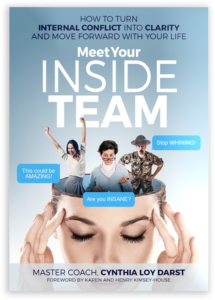Dan Weil, CPCC
Would You, Lie to You?
I’ve been watching old episodes of Britain’s “Would I Lie to You?” (WILTY) It’s a long-lived panel-based parlor game show available via YouTube if you don’t have subscriptions to other resources.
It cracks me up as a panel or team works to lie in such a way that the competing team must guess — is the story a lie, or is it the truth? Generally, the stories told are hysterical. Sometimes, they demonstrate some vulnerability.
Is Mick really James’ hated archenemy?
Is Bob really a certified dog masseur? (see video below)
I wonder about this format as a metaphor for dealing with our own internal conversations with our Inside Team of characters.
Inside each of us is a collection of internal voices, parts, and beliefs that sometimes work in harmony and sometimes doesn’t.
The Inside Team approach shows you how to go behind the curtain to discover how you think and understand what these parts of you really want.
Cynthia Loy Darst, MFA, CPCC, ORSCC, MCC
Author of “Meet Your Inside Team”
Visit Cynthia at teamdarst.com
I especially like the part of this game that names a particular story we may be telling ourselves — and then the curiosity others must play with to identify what the truth is and what’s the lie.
Admittedly, this format is a bit more complex, with two different teams playing against each other to see who can score against the other, lie or truth.
I enjoy this as one playful model of playing with our own Inside Team members and how we might look at owning our truth or digging deeper to check in, “Is this a truth? Or is this a lie?” Being playful lightens the mood and lessens the harmful effects of being overly judgemental of ourselves, others, and of situations.
The story I tell myself is that I’m an imposter, and I don’t belong here.
If I deploy the WILTY model in this internal game, I would pause for a moment and dig deeper to check in. I’d ask a few questions to determine if I’m listening to a truth or a lie. Then, I would dig deeper and look to find out, well – if this is a lie, then who’s the one bringing this lie forward? Going further, I would ask, “What do they really want to tell me? What’s the one or two percent of truth in this lie?”
This is a lie because I know that the truth is I am qualified, I am capable, I know how to do this, and I do this very well.
So, what’s the truth in the lie?
If I interview or quiz the one bringing forth the imposter lie, I might investigate, “Which one are you? Are you a team player or a saboteur? Where do you get this imposter idea? Are you repeating an old lie? Tell me more about this lie…”
Whatever the story is, we can quickly stop the story by asking, “Truth or lie?” We can also build our resilience by getting curious. Curiosity creates clarity and supports faster management of negative self-talk when it appears again in the future.
We have several tools in our toolbox that help us to manage our internal environment. Utilizing the Inside Team work is one handy approach that can co-exist with lightness, fun, and play.
Practicing some creative playfulness creates more fun and lightens our life and work experience while we continue to grow our personal development.
I’m curious! What’s the most outrageous lie you’ve told yourself? What do you want to do about the lie you tell yourself?
Caution! These videos may lead you down a rabbit hole.
Coaches continually get coached themselves and evaluate where they are in their process all in service of their clients.




